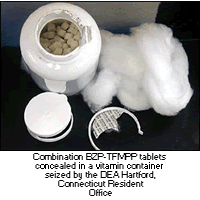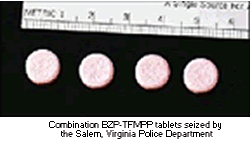Drug Intelligence Brief
BZP AND TFMPP: CHEMICALS USED TO MIMIC MDMA'S EFFECTS
December 2001
 OVERVIEW OVERVIEW
Benzylpiperazine (BZP) and trifluoromethylphenylpiperazine (TFMPP),1
are increasingly trafficked as MDMA (Ecstasy). These chemicals, which
produce stimulant and hallucinatory effects similar to MDMA, are not currently
listed under the Controlled Substances Act. In 2000, federal, state, and
local authorities began seizing increasing amounts of tablets, capsules,
and powder containing either BZP or TFMPP or more commonly, a mixture
of both chemicals. Evidence indicates that some traffickers use these
chemicals as substitutes for MDMA. Although deaths and overdoses associated
with these chemicals have not been reported in the United States, the
potential for adverse
reactions exists.
BACKGROUND
BZP and TFMPP are part of a class of chemical compounds known as piperazines,
which are used as chemical intermediates in the production of certain
detergents and pharmaceuticals. Piperazines are also used in medications
to treat parasitic infections, and are metabolites in some drugs used
to treat depression, anxiety, and hypertension. Medical research continues
on the use of piperazine derivatives as possible vasodilators and tumor-reducing
agents. Current studies related to piperazines mainly concentrate on the
effect these chemicals have on the serotonin systems of the brain.
 USE
AND EFFECTS USE
AND EFFECTS
Adolescents and young adults involved with the current rave culture are
the primary abusers of these chemicals, sometimes referred to as “Legal
E” or “Legal X.” Dealers and abusers, however, may not
know they are selling or ingesting BZP or TFMPP. In some seizures, tablets
containing BZP and TFMPP were confiscated along with tablets containing
MDMA.
BZP is reported to produce stimulant effects similar to amphetamine,
while TFMPP has the reputation of producing the psychoactive effects of
MDMA. Increased heart rate, blood pressure, and body temperature also
have been associated with the ingestion of some piperazine derivatives.
In high doses, piperazines produce hallucinations, convulsions, and respiratory
depression. BZP and TFMPP are also skin irritants; therefore, individuals
who inhale powder or crushed tablets may develop sore throats and nasal
passages.
No deaths or overdoses in the United States have been attributed to the
ingestion of BZP or TFMPP. According to a report from University Hospital
in Zurich, Switzerland, one overdose death was associated with BZP.2
A young female attending a rave party ingested two capsules of BZP, one
tablet of MDMA, and approximately 10 liters of water over a 15-hour period.
She experienced a frontal headache, minor malaise, disorientation, dizziness,
and somnolence before succumbing to death as a result of hyponatriemia
(low sodium levels) and massive brain edema. The exact role of BZP in
this case is not known.
MANUFACTURE/PRODUCTION
BZP, TFMPP, and other piperazine derivatives are legitimately manufactured
in India and may be purchased in Europe, the United Kingdom, and the United
States through several bulk chemical supply companies. BZP and TFMPP are
relatively inexpensive costing approximately $0.40 and $4.50 per gram
respectively. The clandestine manufacture of BZP and TFMPP has not been
reported in the United States. However, BZP and TFMPP powder has been
encapsulated or pressed into tablets by organizations operating in the
United States. A majority of the tablets seized have contained both BZP
and TFMPP. Tablets analyzed by federal, state, and local laboratories
indicate that they typically weigh between 200 and 500 milligrams and
usually contain a 2:1 ratio of BZP to TFMPP.
 DISTRIBUTION
AND TRAFFICKING DISTRIBUTION
AND TRAFFICKING
The distribution of BZP and TFMPP is minor in comparison to MDMA. The
primary illicit distributors of these chemicals are domestic organizations
with connections to overseas sources of supply. Since BZP may also be
obtained from both illicit and legitimate websites, some organizations
and individuals may also use the Internet to facilitate purchases.
Illicit organizations are suspected of importing the chemicals either
directly into the United States or through Mexico. Once the chemicals
reach the United States, the BZP and TFMPP powder is processed into capsules
and tablets, sometimes with logos so that they resemble MDMA. The finished
product is primarily sent via overnight delivery services to distributors
or customers throughout the United States—sometimes concealed in
vitamin containers. These organizations also distribute other drugs such
as marijuana, MDMA, 2C-B (Nexus), ketamine, and steroids.
In Europe, BZP, known there as A2, is sold legally through websites and
is touted as a cheap and safe alternative compared to illicit amphetamines.
Also, in New Zealand, a company that promotes BZP as a stimulant legally
markets the chemical under the brand name “Nemesis.”
 SEIZURES SEIZURES
Since 2000, seizures of BZP and TFMPP tablets, capsules, and powder have
increased in the United States. Seizures have occurred in California,
Connecticut, Florida, Illinois, Iowa, Louisiana, Minnesota, Rhode Island,
Texas, and Virginia, at the dealer and user levels. In 2001, federal,
state, and local authorities effected several large seizures of BZP, TFMPP,
and other piperazine derivatives in tablet and powder forms. Approximately
5,000 tablets were seized in Norwich, Connecticut; 1,008 tablets in Sioux
City, Iowa; and 1,000 pounds of powder in Austin, Texas.
BZP and TFMPP have been commonly marketed either as pink, tan, white,
green, purple, or off-white pills. These tablets have been imprinted either
with a fly, crown, heart, butterfly, or bull’s head logo; however,
some have no logo. In addition, these chemicals have also been seized
in clear capsules containing an off-white powder.
CONCLUSION
The Drug Enforcement Administration continues to investigate and gather
intelligence on organizations involved with the importation, trafficking,
and distribution of BZP, TFMPP, and other related substances. As previously
stated, BZP, TFMPP, and other piperazine derivatives are not currently
controlled; however, efforts are underway to gather the necessary data
to determine whether emergency or traditional scheduling is warranted.
Individuals and organizations currently trafficking, distributing, or
possessing these substances with the intent for human consumption, can
be prosecuted under federal and most state drug-analog statutes.
1 1-Benzyl-piperazine and
1-[3-Trifluoromethylphenyl]-piperazine
2 Balmelli A, Kupferschmidt
H, Rentsch K, Schneemann M. Department of Internal Medicine, Institute
of Clinical Chemistry, Division of Clinical Pharmacology and Toxicology,
University Hospital, Zurich, and Swiss Toxicological Information Centre,
Zurich, Switzerland, 2001, XXI International Congress of EAPCCT, Barcelona.
| This report was prepared by the Domestic Strategic
Unit of the Office of Domestic Intelligence. This report reflects
information received prior to November 2001.Comments and requests
for copies are welcome and may be directed to the Intelligence Production
Unit, Intelligence Division, DEA Headquarters, at (202) 307-8726. |
DEA-02005
|

